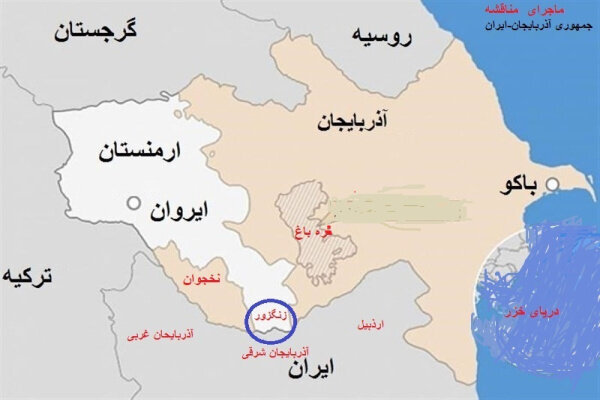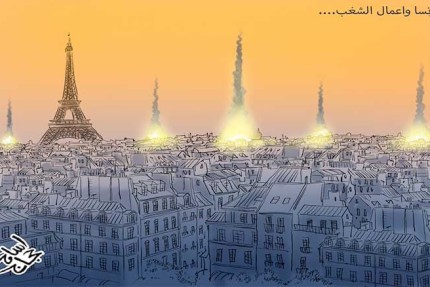Newvisiona
Zangezur: NATO’s Gateway to Iran’s Northern Borders?

Zangezur corridor that appears to be built as an economic project for connecting Nekhjavan to Azerbaijan Republic is in fact an instrument for redesigning the geopolitical setting of the Caucasus region, to exclude Iran from the transit routes and to restrengthen western penetration into the northern areas of Iran.
According to Negaheno report in a very sensitive area such as southern Caucasus region no construction project is seen with merely economic intention for connecting the infrastructures.
The Zangezur corridor which aims to connect lands between Azerbaijan Republic and Nekhjivan via Armenia territory is a clear example of this very geopolitical fact. This corridor looks like a project for facilitating trade and transit but in fact, it is part of a wider strategy that is directly supported by the US and Turkey; a project for weakening Iran’s regional status and redesigning the penetration plan in the surrounding regions of the Islamic Republic of Iran.
Strategically, the Zangezur project is one of US’s new instruments for reinforcing its position in the southern Caucasus region since the Karabakh second conflict. The ultimate goal of this project is to exclude Iran and Russia from the main routes of energy transit in the Middle East to Europe and to open a new route that would cross Baku controlled territories via Nekhjivan and Turkey to Europe.
This route would not only restrengthen the Top and Tanap gas lines but it is also in line with the West’s long-term policies for reducing Europe’s dependence on Russia’s energy. In the meantime, Iran is to be marginalized as a route that is traditionally a safe route for east -west transits, and would have deep security and economic consequences for Tehran.
From geopolitical standpoint the Zangezur corridor would mean no other than marginalizing Iran’s strategic role within the region. Previously, when Iran introduced initiatives such as the north- south corridor in order to strengthen its position within the Eurasia transit lines, now it is encountered with project that would exclude its influence in the southern Caucasus. This is when on the other side the western axis comprised of the US, Turkey, Israel and Baku are extending their operational field, a field that is pursuing its intelligence and security aims in addition to the economic goals.
Against this new bloc the traditional Eurasia route stands comprised of Iran, Russia and China. China with the road -belt project is trying to redefine global trade routes from Asia to Europe; Russia also despite the pressures resulting from the Ukraine war continues to believe in itself as an effective player in the Caucasus region.
Meanwhile Iran stands as the connecting point of two eastern powers and guarantees balance in the region. However, Zangezur is a threat to this balance. If this corridor is to be implemented without considering Iran it would literally cut off Iran’s geographical penetration in north Caucasus. A change that would distance Iran from the strategic neighboring with Armenia and would allow nonnative players in the northern areas of the country.
The recent position of the president of Azerbaijan republic and his emphasis on completing the Zangezur corridor until next spring indicates Baku’s strong will to implement this project; a project that clearly is moving forward without coordinating with Tehran and is against Iran’s geopolitical interests.
Zangezur corridor is in fact, a meeting point of several competing layers within the world and regional power blocs. In this geopolitical battle if Iran fails to have a determined and timely move it would not only be put aside from the trade routes but also geopolitically marginalized and its security put under threat in the northern borders of the country.
This project is a serious test for Iran’s foreign policies during the regional redesigning era, a test that would not be solved simply through diplomatic instruments but it requires a strategic planning, field presence and multilayered unity.
Comment
- Trump Will Destroy Both the US and the World
- We Will Not Allow Any Foreign Intervention in the Prime Minister’s Election
- Restructuring Power within Shiite Coordination: Signs of a New Agreement
- Iraq and post- elections:Participation increased after 20 years
- Some Key Points on the 2025 Parliamentary Election in Iraq
- Trump Will Destroy Both the US and the World
- We Will Not Allow Any Foreign Intervention in the Prime Minister’s Election
- Restructuring Power within Shiite Coordination: Signs of a New Agreement
- Iraq and post- elections:Participation increased after 20 years
- Some Key Points on the 2025 Parliamentary Election in Iraq
- What is Happening in Sudan These Days? From Planning to Disintegration to Marginalizing the Crisis in Gaza
- Hesam Al-Rabiee: The Prime Minister’s Position has Turned Unimportant in Iraq.
- Israel is After Forced Displacement of Palestinians in Several Stages
- International expert: The US is Dealing with the World Based on Hegemonic Principles
- Sharm-ul Shaikh or Sharm ul-Shaikhs? Trump Desires to Go to Paradise from Ukraine and Gaza
- October 7th Regained the Arab and Muslims’ Honor and Dignity
- “Donald Trump is a selfish dictator
- Hamas Reaction to Trump’s Plan is Logical and Results from National Duty
- Trump Will Destroy Both the US and the World
- We Will Not Allow Any Foreign Intervention in the Prime Minister’s Election
- Restructuring Power within Shiite Coordination: Signs of a New Agreement
- Iraq and post- elections:Participation increased after 20 years
- Some Key Points on the 2025 Parliamentary Election in Iraq
- What is Happening in Sudan These Days? From Planning to Disintegration to Marginalizing the Crisis in Gaza
- Hesam Al-Rabiee: The Prime Minister’s Position has Turned Unimportant in Iraq.
- Israel is After Forced Displacement of Palestinians in Several Stages
- International expert: The US is Dealing with the World Based on Hegemonic Principles
- Sharm-ul Shaikh or Sharm ul-Shaikhs? Trump Desires to Go to Paradise from Ukraine and Gaza




